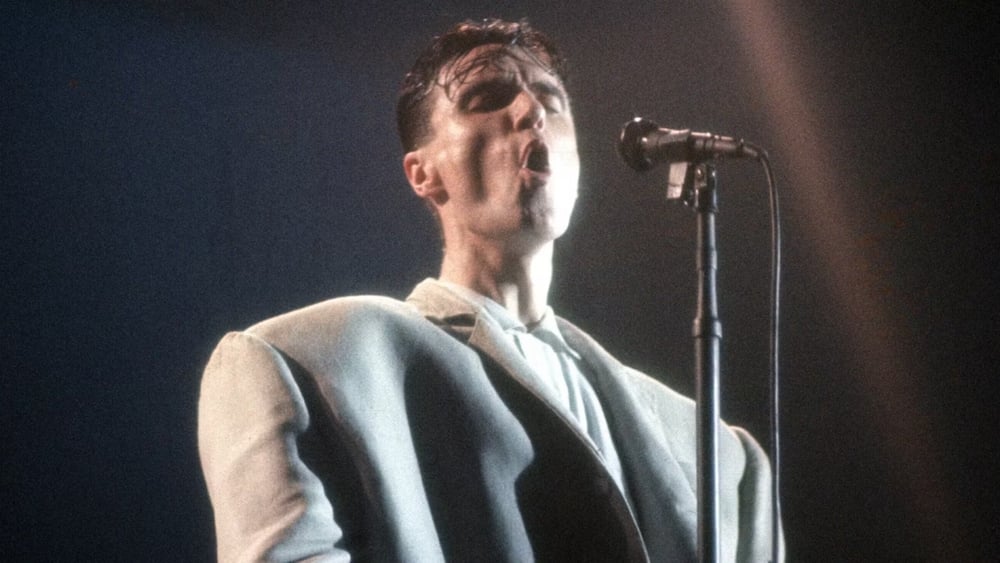-
40 years later, there's still nothing like 'Stop Making Sense'
by Mitchel Green - October 5, 2023
|
mitchelgreen34@gmail.com
 source: The Movie Database
source: The Movie Database
As someone who primarily listens to older music, most of my favorite artists are impossible to see live because they aren’t active anymore — though seeing Bob Dylan in concert my first year of college was maybe as close as I’ve come to having a religious experience. Despite this, I have never understood the appeal of concert docs. That feeling may stem from viewing circumstances rather than anything inherently wrong with the form itself. If there even are concert docs for my favorite groups, they haven’t been in theaters for 40-50 years (and haven’t gotten repertory screenings in my city that doesn’t have a theater that regularly shows older films). As such, I’ve been stuck viewing these films at home on my television or, god forbid, on my laptop. What kind of a way is this to experience a kind of movie that can start with a title card that reads “THIS SHOULD BE PLAYED LOUD!”?
Concert docs are supposed to be experiences, at least making you feel like you were there when it happened and at best making you feel as though you’ve experienced a show in a completely new and improved way. Viewed at home with less-than-ideal sound, they fail to be experiences and, instead, become documents — vessels for storytelling that convey what happened during the concert. As a result, concert docs generally become boring when viewed this way because these films were never meant to be informative, they were meant to be felt. Even something like “Gimme Shelter,” which attempts to tell the story of the deadly disaster at the Rolling Stones’ 1969 Altamont Speedway concert, focuses most of its runtime on the music rather than the tragic end. The filmmakers don’t know whether or not they want to make an experiential film or a statement about the violent end of the ‘60s and they end up doing neither.
That being said, concert docs often have one major problem in common that would hold them back even if viewed in a theater. With few exceptions, they don’t work as movies. They aren’t interesting to look at, usually opting for basic coverage that ensures everything worth seeing is visible. Little thought is put into composition or editing — funny, however, that two of the major exceptions to this, “Woodstock” and “The Last Waltz,” both were made with the involvement of Martin Scorsese, who might know better than anyone how to make music cinematic — and if you aren’t into the music being played, the film becomes pointless to watch.
What is so refreshing about how Jonathan Demme and Talking Heads handle shooting the concert in “Stop Making Sense” is they seem to have found a way to make watching the show exciting as a movie rather than just a filmed concert. A lot of this is in the band’s performances. The group combines the propulsive force and nihilism of punk rock with the grooviness of funk to create a grooving mania that no other group in the last 40 years has been able to replicate. Frontman David Byrne’s erratic movements and bizarre costumes fill you with joy and adrenaline that makes you want to get out of your seat and join in (supposedly dance parties have broken out at various screenings, but despite moving around in my seat, nothing of the sort happened at my theater). The rest of the group matches but never overshadows Byrne’s energy, and each gets their moment to shine — to open the film, each song adds another member of the group, showcasing what everyone brings individually to the band’s unique sound.
Even if you aren’t a fan of Talking Heads’ music, there is still plenty to admire about the theatricality of the concert. The production design is often completely deranged, a perfect match for the band’s inherent weirdness. The use of harsh shadow creates an eerie feeling that wouldn’t feel out of place in a German expressionist horror film. Unlike most concert docs, you feel Demme had an idea of where to put the camera, which allows him to pull off slicker camera tricks like the opening tracking shot following Byrne’s feat and setting down the boombox before launching into “Psycho Killer.” The blocking of the performers feels controlled and intentional as if it were more a stage show than a standard rock concert, and yet it’s able to maintain a feeling of freedom that Byrne’s twisting movement demands. All of this is edited together with a rapid, relentless pacing that makes “Stop Making Sense” feel like a nonstop jolt of energy.
“Stop Making Sense” is the greatest concert film ever made, but it shouldn’t even be lumped in with what is often such an empty, lazy type of movie. These films rarely use the visual language of cinema in a way that makes them worthwhile as viewing experiences and often make you feel that you’d rather just be at the concert. But Demme’s film both brings the concert vibe to the theater and works as a creative piece of filmmaking. You could watch it with the sound off and still be moved by the audacious, provocative visuals. Seeing this for the first time, with a beautiful new restoration on the big screen, filled me with a euphoria few films have been able to match.

